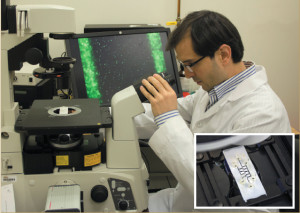
ECS student member Alireza Mahdavifar observes live bacteria moving inside the microfluidic channel.
Image: Georgia Tech/The Poultry Site
Along with a team of researchers out of Georgia Tech, ECS student member Alireza Mahdavifar has designed and fabricated the prototype of a microfluidic device that exploits cell movement to separate live and dead bacteria during food processing.
The research, entitled “A Nitrocellulose-Based Microfluidic Device for Generation of Concentration Gradients and Study of Bacterial Chemotaxis,” has been recently published in the Journal of The Electrochemical Society.
The new development consists of a microfluidic device that exploits cell movement to separate live and dead bacterial during food processing. The device is novel due to the fact that while screening for foodborne pathogens, it can be difficult to distinguish between viable and non-viable bacteria. Mahdavifar and the team out of Georgia Tech responded to this issue by creating a device that can separate live cells from dead ones for real-time pathogen detection.
The key behind this development is chemotaxis – or the movement of an organism in response to chemical stimulus. By changing the local environment of the cells, their movement can be manipulated so all the viable cells can be separated and concentrated, thereby improving detection.
This from The Poultry Site:
The bacteria interact with these chemicals in the centre channel and then move based on the nature of these interactions, either toward it if it is a food source or away if it is a repellant. The separated bacteria are then collected in the channel’s respective outlets In recent experiments, E. coli 0157:H7 was used as the model bacterium, and aspartic acid (an attractant) and nickel ion (a repellent) were used as the chemotactic effectors.
“This innovation includes an inexpensive and scalable fabrication process and the use of disposable and bio-compatible materials that make it suitable for laboratories and field testing around the world,” said Mahdavifar.
Along with being an active student member of ECS, Mahdavifar was awarded Best Presentation for the team’s poster entitled “A Cost-Efficient Microfluidic Device for Study of Chemotaxis and Bacteria Separation Purposes” at the 224th ECS Meeting in San Francisco, California.
ECS offers a variety of options for students to get involved, including a robust student chapter program. For more information, please click here.


